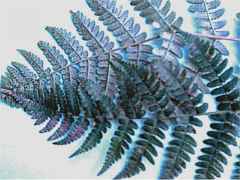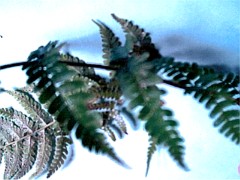Many kinds of ferns can be propagated by
division, a few by means of plantlets that develop on the mature fronds.
Ferns are also increased by spores. (They do not form seeds; the spores are
sown and can be treated as very fine seeds, except that the soil or other medium
on which they are sown must be serialized by heat or other means before sowing.)
With some kinds of ferns the spores are developed on special fertile fronds
only, and all other frond are sterile (non-spore-bearing), but most ferns may
bear spores on the undersides of
all mature fronds. The ripe spore fall to the ground and produce small, flat
plant bodies quite different in appearance to the parent plant; these in turn
produce ferns as we know them. But the propagation of ferns from spores is
complicated...
of
all mature fronds. The ripe spore fall to the ground and produce small, flat
plant bodies quite different in appearance to the parent plant; these in turn
produce ferns as we know them. But the propagation of ferns from spores is
complicated...
For ferns from spores, sterility is of utmost importance with the container, the medium (The best media for germinating spores are sterile soil-less mixtures of peat or sphagnum moss with perilite and/or vermiculite) and the container and the water should be boiled and cooled before use. Dust the spores (which actually look like dust; you can mix a teaspoon of table sugar with the spores to facilitate spreading) on the surface of the medium, not covering them. Make sure you water before spreading the spores as watering after will wash the spores into the media, and most likely not germinate properly. Then cover the container with a piece of glass or plastic and set it on a container of water so the medium will be constantly moist. Temperature should be maintained at 60-70 degrees.
Within a few days to several weeks, a green moss-like growth will appear on the surface of the medium. Don't be alarmed, this is the prothallia starting to form, the first step in the life cycle of a fern. The prothallia will become flat, thin, heart-shaped structures within another one to three months. At this point the female egg cells in the prothallia are fertilized by the male spermatozoids (present with the spores) and the new fern starts to develop.
Once they're recognizable babies,
transplant the young ferns into a flat (another sterile container) at one inch
apart. When the fronds start to touch, move each fern into its own 2" or 3" pot.
This whole process may take 8-12 months, so be patient. Prevent the young ferns
from drying out by keeping them in a covered container or
terrarium.
